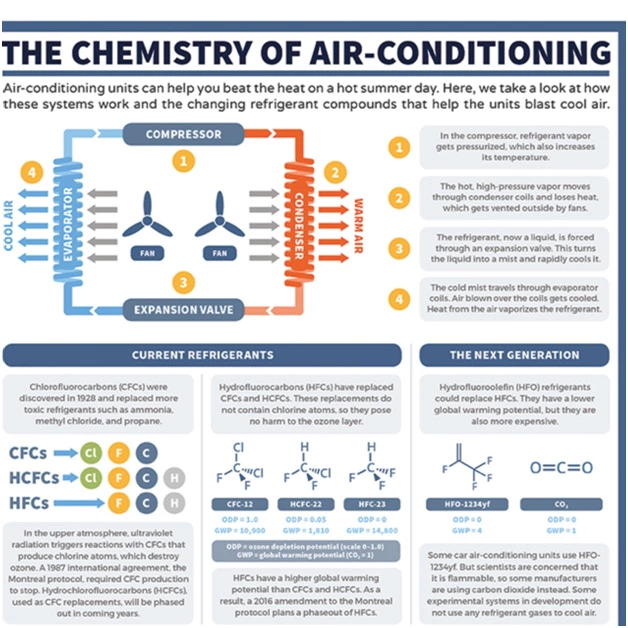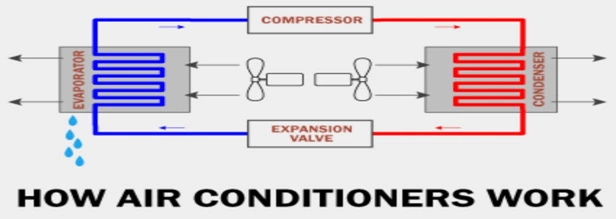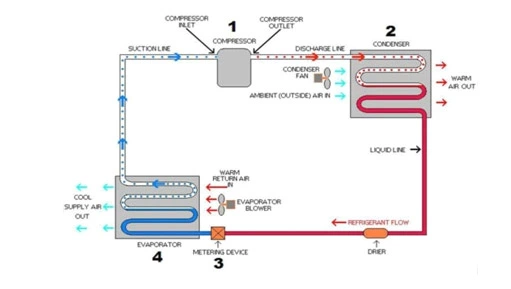The air conditioner is an essential device in summer. It helps to maintain the optimal temperature in our rooms. Here, one question usually arises in our minds that whether an air conditioner is an endothermic or exothermic device? Most of the air conditioners have motors that drive compressors and fans. These motors of air conditioners and other devices produce heat, making an air conditioner unit an exothermic device.
The function of an air conditioner is to move thermal energy from one place to another (from inside the house to outside the house). Some neutral air conditioners require no energy to move heat. They are neither endothermic nor exothermic.
An air conditioner works very hard to cool and condition your room. It utilizes refrigerants like carbon tetrachloride to help you manage your summer!

How an air conditioner is both an endothermic and exothermic device?
Some researchers believe that an air conditioner is both an endothermic and exothermic device.
- If we look at the refrigerant of the air conditioner it carries out both endothermic and exothermic processes.
- If we focus on the fan coil unit- the liquid refrigerant absorbs heat from the air in the room and becomes refrigerant vapor. Here, the air conditioner works as an endothermic device.
- At the compressor unit- the refrigerant vapor is compressed and condenses to liquid refrigerant. The heat from the compression and condensation is transferred to the air outside the room. Here, the air conditioner works as an exothermic device.
- But if we consider the whole air conditioning system, there is a net heat gain to the environment. As it uses electricity and converts it to mechanical power; absorbs some heat from the inside of the room, but generates more heat to the outside of the room.
That’s why the air conditioner is considered as a net source of Global Warming and exothermic device as well.
How do you know or predict about endothermic and exothermic?
An endothermic reaction soaks up heat. An exothermic reaction always releases heat as the reactants have more energy than products. The term endothermic and exothermic depends on the difference of energy or more enthalpy between the reactant or the product. If the sum of enthalpies of reactants is greater than the products, the reaction will exothermic. If the product side has a larger enthalpy, the reaction is endothermic.
The principle of an air conditioner
Air conditioners and refrigerators work on the principle of reverse engineering. It converts work into heat. They use a substance called coolant or refrigerant. Coolant changes from a gas to liquid as it goes from higher temperature to lower temperature. This change from gas to liquid is a phase change and depends upon the intermolecular forces. Phase change occurs as constant pressure. For the phase change involving the breaking of intermolecular forces, heat is added and ∆H is positive because the system is moving from lower enthalpy to higher enthalpy. So, the process of fusion, vaporization, and sublimation are endothermic phase transitions.

For the phase transition involving the formation of intermolecular forces, heat is released and ∆H is negative because the system is going from a higher enthalpy phase to a lower enthalpy phase. Hence the process of freezing, condensation, and deposition are exothermic phase transitions.
How does Ac work?
An air conditioner takes warm air from your room and cools it down until you have a livable temperature. It is revealed after studies that if it is over 100 ᵒF outside, you might want it to be about 30 ᵒF inside. So, you will tell the air conditioner to change it and cools your room. But the question arises here that how does it manage that? An air conditioner has a refrigerant in it that cools the air as it cycles back into your room, allowing you to live more comfortably inside the room. You have observed that most HVAC technicians come to your home to check refrigerants and the efficiency of your air conditioner unit. So, why not you learn about its working? It is very simple based on some simple steps. These are explained below:

Compress
The first thing that occurs in a refrigerant system is the compression of the refrigerant. The refrigerant is a chemical substance that changes from liquid to gas. When the refrigerant is pushed into the compressor, it is a low-pressure gas. The compressor pushes these gas molecules together, heating them as the pressure rises. The compressor is the piece that keeps the refrigerant moving, as the low pressure is continuously pulled into a compressor to try and create some sort of equilibrium. This piece requires more care because the piping easily burns.
Condense
Once the refrigerant is compressed and pressurized, the hot gas is moved into the condenser. The compressor of the air conditioner faces the outside of the house. When you will observe the condenser, you will find that there is hot air being released out of it. Now you will think about whether all this heat comes from inside of your room? Aircon condenser has a few fans that blow across few pipes and cools the gas. When those fans are cooling the gas, the pressure will pull the molecules lighter together, and the refrigerant will condense again into a liquid. The temperature drops to an optimal level. The liquid gets heat from your home burned off and begins to move along to the next part of the unit.
Measure
If you want the refrigerant to move at a constant speed, and to check whether the air conditioning is continuing to cool the room. The metering device is the computer that controls the situation and monitors, how things are working. If you are having an electrical problem, or your air conditioning is not responding to your programming, it might be due to this small device. The hot refrigerant then will move through the device.
Evaporate
At last, the low-pressure liquid will encounter the evaporator. With low pressure, the refrigerant liquid is ready to cool the room. The evaporator fans will blow over the pipes and the pressure will change. The chemical absorbs heat and reacts by boiling through an endothermic process. It means when it gets energy in the form of heat and evaporates into a gas again, the chemical absorbs the heat energy from the room, causing the temperature to drops in the surroundings. More refrigerant is pumped into the evaporator; more warm air from the room is cooled through the endothermic process. The gas is again pumped into the compressor and the cycle continues.


